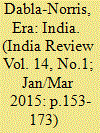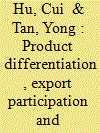| Srl | Item |
| 1 |
ID:
112728


|
|
|
|
|
| Publication |
2012.
|
| Summary/Abstract |
This paper presents a meta-analysis of 5308 observations of total factor productivity growth (TFPG) in China from 150 primary studies to provide some insightful explanations to the controversies about productivity growth in China in the current literature. The main findings include that (1) the mean TFPG of the aggregate economy at the national level in the current literature is only about 2% after 1978, which barely contributes to 20% economic growth; (2) there are three cycles for TFPG after 1978 and each circle lasts about 10 years; (3) sector-specific TFPGs are generally larger than aggregate economic TFPGs; (4) regional disparities of TFPG are significant and specifically the TFPG in East China is higher than that in Central and West China; (5) TFPG after 1978 is in general greater than that before 1978; and (6) peer-review process and paper languages are significantly correlated with TFPG results.
|
|
|
|
|
|
|
|
|
|
|
|
|
|
|
|
| 2 |
ID:
138117


|
|
|
|
|
| Summary/Abstract |
India experienced unprecedented growth during the past two decades against the backdrop of wide-ranging “first generation” of reforms, growing trade and financial integration, buoyant external demand, and ample global liquidity. Like other emerging markets (EMs), India also enjoyed a good measure of macroeconomic resilience, evidenced by the fact that the Indian economy rebounded from the global financial crisis much sooner and faster than advanced and indeed, many other emerging market economies.
|
|
|
|
|
|
|
|
|
|
|
|
|
|
|
|
| 3 |
ID:
159053


|
|
|
|
|
| Summary/Abstract |
This paper examines the effects of public subsidies across several dimensions of the innovation process and the implications for productivity. As an identification strategy, panel data is used to estimate a structural innovation model that controls for unobserved heterogeneity combined with matching techniques that help ensure comparability between subsidized and non-subsidized firms. The findings reveal that public subsidies reduce firms' economic performance in lower and higher technology industries despite promoting indigenous innovation in the higher technology industries. Policymakers may tolerate lower average efficiency if they expect that some of the state-backed firms will eventually become successful innovators that go on to generate significantly large social welfare payoffs. Although the findings do not support such an expectation, thus bringing into question whether the social payoff from China's so-called picking ‘winners' strategy justifies the cost.
|
|
|
|
|
|
|
|
|
|
|
|
|
|
|
|
| 4 |
ID:
149772


|
|
|
|
|
| Summary/Abstract |
In this paper, we investigate how the degree of export participation and product differentiation affect firms' productivity growth through learning-by-exporting. We extend the model of Melitz and Ottaviano (2008) to endogenize the effort firms allocate to learning. This effort choice depends on both the degree to which firms enter export markets and the extent to which products are differentiated across producers. Using a firm-level dataset from China's manufacturing industries, we implement propensity score matching methods to test the model's predictions. Our results indicate that the degree of export participation is positively correlated with TFP improvements. Simultaneously, we empirically verify that firms exporting less differentiated products experience faster TFP growth than those exporting more differentiated products.
|
|
|
|
|
|
|
|
|
|
|
|
|
|
|
|
| 5 |
ID:
132778


|
|
|
|
|
| Publication |
2014.
|
| Summary/Abstract |
In this paper we adopt the methodology proposed by Olley and Pakes to estimate total factor productivity in Chinese manufacturing industries using the 2001-2007 annual survey of manufacturing factories. The changes in TFP are decomposed both at the sectoral and the industry level using the Baily-Hulten-Campbell and Syrquin approaches. We find that the nature of growth of Chinese manufacturing has not changed fundamentally during the period, particularly in terms of the high dependence on intermediate inputs. At the inter-industry level, current changes in TFP mainly originate from the increase in the internal TFPs of different industries. Although the influence of structural adjustment on TFP is positive its value is still low, suggesting that significant potential for improvement in productivity in manufacturing through adjustments in structure still exists. At the intra-industry level, the improvement in TFP in different industries can be mainly attributed to the reallocation of resources and output quotas, which results from enhanced competition.
|
|
|
|
|
|
|
|
|
|
|
|
|
|
|
|